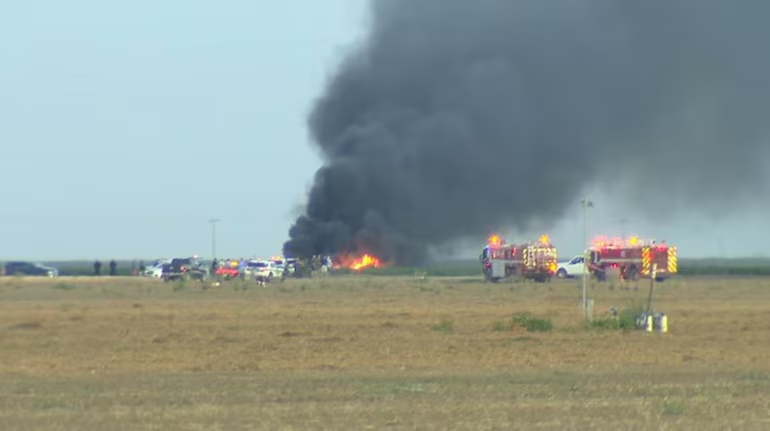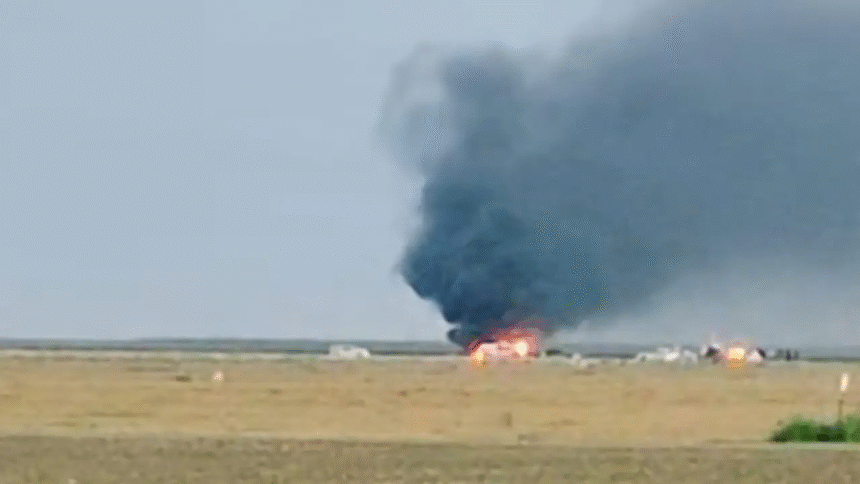F-35 Fighter Jet Crashes in California – $100M Stealth Aircraft Down, Pilot Ejects Safely
A $100M F-35 stealth fighter jet crashes in California during a training mission. Pilot ejects safely. Investigation underway as defense officials react
California, July 31, 2025 — In a dramatic and high-stakes incident that has sent shockwaves through military and aviation circles worldwide, a state-of-the-art F-35 Lightning II stealth fighter jet, worth an estimated $100 million, crashed in Southern California during a routine training mission. The pilot ejected safely moments before the jet went down, avoiding fatalities in what could have been a catastrophic disaster. The incident occurred near the highly secure Edwards Air Force Base, a vital hub for U.S. defense aviation testing.

As the most expensive and technologically advanced fighter jet in the world, the F-35 crash is now under intense scrutiny by the U.S. Air Force, Lockheed Martin, and federal aviation safety boards. It is the latest in a series of concerning accidents involving the fifth-generation aircraft, raising questions about operational risks, program costs, and military readiness.
According to official reports from U.S. Air Force Command, the incident occurred at approximately 2:38 PM local time during a standard air combat maneuver training sortie. The pilot—part of the 412th Test Wing at Edwards AFB—was performing an aerial systems check at high altitude when unexpected anomalies began to affect flight control systems.
Eyewitnesses from nearby California City reported hearing a loud boom followed by the sight of a parachute descending from the sky and a plume of smoke rising from the crash site located roughly 10 miles northeast of the base’s perimeter.
Emergency crews responded within minutes. The pilot was airlifted to a nearby military medical facility and later declared to be in stable condition with minor injuries.
The crash site was quickly sealed off by Air Force Security Forces, and investigative teams from the Air Force Safety Center and Lockheed Martin arrived on scene to begin recovery and data analysis efforts.
The F-35 Lightning II, developed by Lockheed Martin, is a fifth-generation stealth multirole combat aircraft capable of ground attack, aerial reconnaissance, and air defense missions. The aircraft incorporates cutting-edge technologies, including:

Radar-absorbent stealth materials
Supersonic speeds exceeding Mach 1.6
Advanced avionics and AI-assisted targeting systems
Vertical landing capabilities (in the F-35B variant)
Interoperability with NATO allies
The F-35 is used by several U.S. military branches including the Air Force, Navy, and Marine Corps, as well as allied nations such as the United Kingdom, Japan, Israel, and Australia.
With a lifetime program cost projected at over $1.7 trillion, it is the most expensive defense program in U.S. history. As of July 2025, over 980 F-35 units have been delivered globally.
This crash is not the first involving the F-35, adding to a growing list of operational incidents:
In 2022, an F-35B crashed while landing on the deck of the USS Carl Vinson in the South China Sea. The pilot ejected safely, but the jet sank and was later recovered.
In 2023, a Royal Air Force F-35 experienced a mechanical failure shortly after takeoff from HMS Queen Elizabeth. The pilot ejected and survived.
In 2024, a Japanese F-35A disappeared during a night training exercise. Debris was found days later, but the pilot’s body was never recovered.
These accidents, though relatively rare given the thousands of flight hours logged, have sparked criticism of the program’s complexity, its cost, and the high maintenance demands of the F-35 fleet.
The U.S. Air Force released a statement confirming the crash and safe ejection of the pilot, emphasizing that the cause of the crash remains under investigation.
“We are grateful the pilot is safe and under medical supervision. A full accident investigation board has been convened to determine the cause of this incident. The F-35 program remains a critical part of our defense strategy, and we take all safety incidents with the utmost seriousness.”
Officials confirmed that flight data recorders (“black boxes”) were recovered and will be analyzed to determine if the failure stemmed from software issues, mechanical malfunction, pilot error, or a combination of factors.
Several defense analysts believe the crash may be linked to software integration or power system failures, common pain points in earlier F-35 variants. The F-35’s reliance on complex computer code and network-linked systems makes it vulnerable to cascading system failures, even during routine flights.
Dr. Steven Collins, an aviation expert from MIT, explained:
“The F-35 is less of a traditional jet and more of a flying computer with missiles. When even a minor digital miscommunication occurs between flight systems, the margin for error shrinks dramatically.”
The Air Force has also previously issued temporary groundings of F-35 squadrons to address component-specific malfunctions, including ejection seat issues, cooling system failures, and helmet interface bugs.
The crash has reignited public debate on the F-35 program, particularly over its cost-to-performance ratio. With over $100 million invested in each unit, critics argue that such crashes are financially unsustainable and demand greater transparency and accountability.
Senator Ron McClellan (D-CA) issued a statement:
“This program has consumed nearly two trillion dollars. We need answers, not just from the Air Force, but from Lockheed Martin and Pentagon oversight bodies. The American people deserve to know if their money is going up in smoke — literally.
On the other hand, military officials defended the F-35 program, highlighting its combat success in operations in Syria, the South China Sea, and NATO exercises.
Lockheed Martin, the F-35’s manufacturer, issued a brief statement:
“We are cooperating fully with the U.S. Air Force investigation. Safety and mission readiness remain our top priorities. We will provide all necessary technical support to assess and address any potential causes.”
Shares of Lockheed Martin (NYSE: LMT) saw a 2.3% dip in after-hours trading, as investor concerns mounted over recurring mishaps in the company’s flagship program.
Though no civilian casualties were reported, the crash site lies close to protected wildlife areas in the Mojave Desert, sparking concern from environmental groups over fuel leaks, wreckage contamination, and groundwater pollution. Clean-up operations are now underway under strict military supervision.








